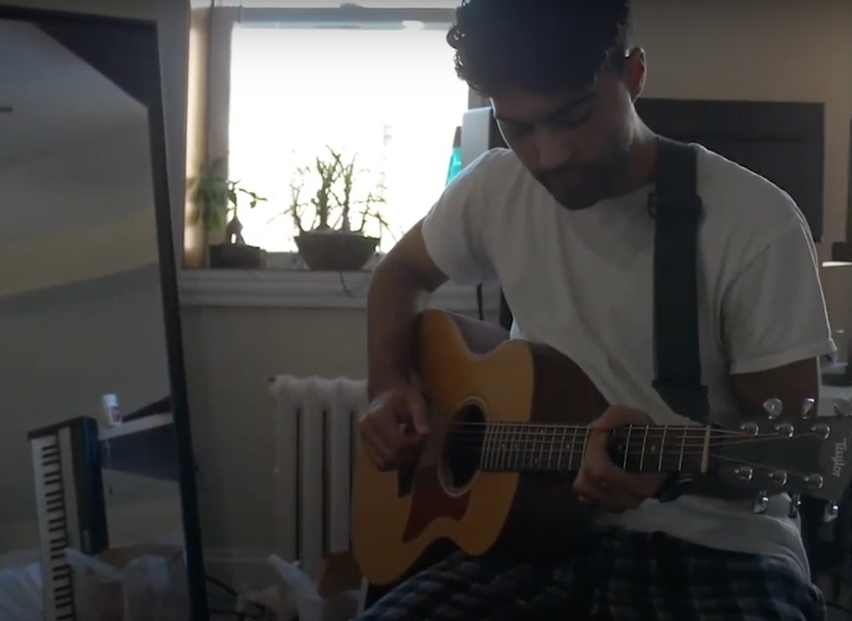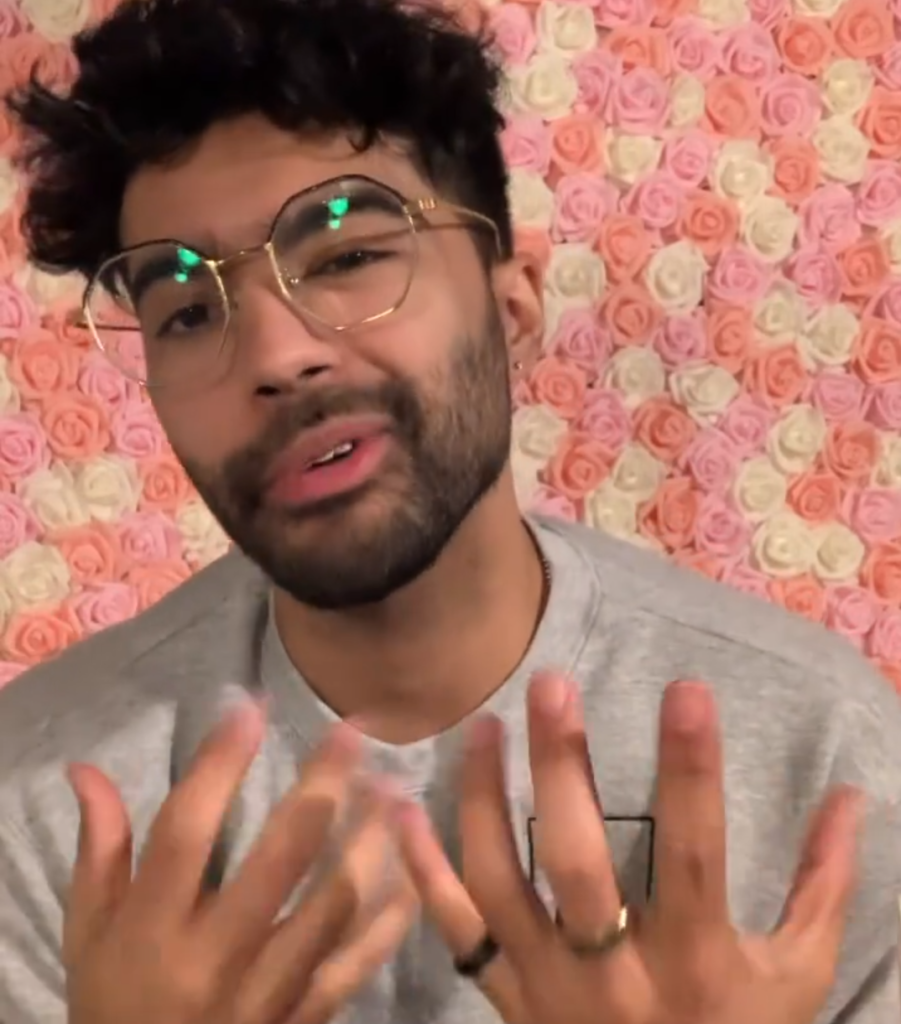“I didn’t think about the entire narrative, that kinda builds on its own in a way.”
I knew Kendric Voss as a charismatic kid from St. Paul, Minnesota that found community wherever he went. He skated, did theater, played clarinet — the kid would have simply been a sphere if he was any more well-rounded. In his multitude of crafts and identities, Kendric was guaranteed to have something in common with you. It was hard to find a person, place, or activity he was unfit for.
More than a decade on, Kendric has funneled his talents and spirit into a career in music. As Keny Grey, he quickly amassed tens of thousands of followers across social media platforms just months after quitting his day job. Through candid interactions with fans and a desire to bond with and serve his deaf/hard-of-hearing family members, Keny Grey, like the young Kendric I knew, is still opening up himself and the world to others.
Years removed from seeing or meaningfully interacting with him, what struck me about Keny Grey’s online presence was the intimacy. I believed and emotionally invested in his music career five seconds into viewing a post about his one-year challenge, a goal he set to make a living off of music before his year’s worth of savings ran out. Along with dreamchasing urgency, his fledgling brand is built on another admirable story: his connection to and support for the deaf/hard of hearing community.
With stripped down contemporary pop records and a self-curated story worthy of peak American Idol, the promise of Keny’s independent artistic journey in this moment had to be captured.
***
But First, Corporate
The kid I knew who would eventually become Keny Grey was always destined for a creative profession. But like many Americans, it took a detour through the corporate world to get there.
“I just kinda bounced around corporate jobs for a while … I was really just trying to make money to fund my music career. I spent all my energy working. Afterward, I’d be so tired I wouldn’t even bother with music.”
This particular piece of Keny’s story isn’t unique. But for a young man who frequented studios with his rapper father as a kid, aspired to dance with NSYNC, and started songwriting and performing at 15 years old, it’s deflating. Contrary to the self-assured path of his music career today, he attended the University of Minnesota because “everyone was going.” He got a degree in economics because his best friend was studying it.
Years into the corporate grind, Keny’s reassessment was simple: his work did not inspire him. Though he was able to save up for a possible music career, he wasn’t even spending what he had to make it happen. Ultimately, Keny decided he could do music if he only did music.
“When you split your attention, nothing wins.”
Making Music
Simply quitting his job and sharing his goals with people gave Keny Grey a new level of self-esteem. This revived confidence has since translated into his creative process, to the benefit of both his music and his brand.
In the studio, songwriting is a fluid process for Keny that simply follows the source of inspiration for the day. Sometimes it’s a type beat online that gets him going. Other times a couple of piano or guitar chords resonate. From there, Keny lets his consciousness flow as his Voice Memos app records the process.
“I’ll work on it for an hour or two and then leave that and come back to it later.”
After some reflection, rearrangement, and editing, Keny has a song.
One of the essential qualities in a Keny Grey song is the minimalism. He takes pride in being able to fill out a song without saying much, engineering his product for a clean, easy listening experience. “Wow,” his most successful single to date, is the perfect example: an aspirational jam with intentionally vague yet captivating tales of love and “making it” all revolving around a triumphant and concise hook. The guitar is sparse and beautiful, the kick thumps in a timely manner, and an airy, hopeful vocal sample injects the space once in a while to complete the vibe.
Music is Business
As dreamy and passionate as Keny’s songs are, his priorities as an independent musician are sobering and wise.
“The music business is 10 percent music and 90 percent music business. We all just wanna make music and just be these creative conduits … but you have to know how to tell your story and make friends along the way.”
Consistent with the introduction of this piece, Keny spends much more time engaging fans and sharing his work than actually producing work. In an era of content overload where artists brag about the size of their discographies and digital vaults of unreleased music, Keny Grey has figured out how to turn a single into an event that lasts months for his listeners.
“Learning how to make a song and then learning how to make people listen to your song. It requires being a people person and making social media content … that in itself is an art.”
“Wow” and the following single “Love Me” each have visualizers depicting Keny signing each song’s key phrase in ASL, a feature tailor-made for the large crowd of deaf/hard-of-hearing fans he has. The music video for “Wow” also features an ensemble of fans signing along to the song so hard-of-hearing fans can enjoy the video as much as fans who can listen.
While listeners do learn a lot about Keny as a person and an artist through his music, the buy-in to both his image and sound happen through consistent, intentional social media posts.
Sometimes it’s a narrated montage on TikTok. Other times it’s sharing a thought in the mirror or a call to action in his comment section prompting fans to text and call him. From the curation of his quit-my-job dreamchasing story to the personal reasons for his deaf/HOH community service, Keny Grey’s biggest strength as an independent artist is his ability to build narratives around genuine aspects of his life.
“Once you figure out what’s true to you, all the thinking is kinda over with. Every time you make a new piece of content you recall who you are and incorporate that into it.”
***
Working With the Deaf/HOH Community
“Everyone loves captions! Even I’ll be watching a video without headphones and be like, ‘Yes, captions!’”
To Keny, losing the ability to use ASL was a significant loss of self. In the same way leaving corporate America reconnected him to music, it’s music that helped Keny reconnect with deaf/HOH family members and forge new connections to hearing-impaired fans.
“I grew up with two deaf grandparents and a younger brother who’s hard of hearing … I didn’t grow up signing a lot. A lot of people experience this loss of culture and language … I hated that I wasn’t able to share my music with all my family. I was like, ‘Hmm, what can I do?’”
Once he began dedicating all of his time to music, Keny used his craft as a space to retrain himself in sign language. As he chronicles his one-year-to-make-it journey, Keny also uses TikTok to share weekly progress as he relearns ASL, tinkers with ideas to use it in his music, then promotes his latest work with features crafted just for hearing-impaired listeners.
Reinvesting himself into music and signing has felt grounding to Keny Grey as much as it has felt liberating. He considers the path he’s currently on a return to his roots.
“It’s part of you even if you’re not fluent. It always had such a deep, personal meaning to me … That’s really why I wanna go back and do something for a community I love and care about.”
Keny Grey has succeeded in making ASL and broader service to deaf/HOH people an essential part of his brand as an artist. The intimate truth of his relationship to that community makes it arguably the strongest part of his brand.
Along with the prevalent signing in his visual content, Keny has also created a captioning service called Grey Captions. What started as a favor for a few friends has become a network of a couple dozen volunteers who caption popular videos so hearing-impaired folks can enjoy them. Keny notes federal communications guidelines which made television accessible for deaf/HOH viewers in the 1990s have been slow to translate to social media. Grey Captions is a small yet successful collective effort in making captioning a norm for online video content to the benefit of everyone — not just the hard of hearing.
“Everyone loves captions! Even I’ll be watching a video without headphones and be like, ‘Yes, captions!’”
While many individual content creators have begun diligently captioning their audio/video work, coordinated efforts like Grey Captions are hard to find. As Keny Grey’s fanbase grows, awareness of Grey Captions may inspire the creation of more services to make auditory content on social media accessible to everyone.
Almost There
At the time of our conversation, Keny was four months into his year-long challenge of making a living off of music. At the time of publication, he’s now a couple months away from the one-year finish line he gave himself in December 2020. While the general trajectory has been upward, Keny was quick to acknowledge both the peaks and the troughs in this short but life-changing timeframe.
“It’s kinda painful in a sense. When you’re so used to being in the same place for so long it’s uncomfortable to succeed. That’s something I have to overcome.”
Keny swears building connections with fans and collaborators is exhausting, but the speed with which his networking results in new material makes it seem effortless. Most recently is his music video for the single “Love Me” shot in Los Angeles in collaboration with actor and dancer Shaheem Sanchez (Sound of Metal). Keny’s “Love Me” collaboration with Shaheem adds to a notable and growing track record of working with deaf creatives and deftly implementing ASL in his visual pieces.
Success in this chapter of Keny Grey’s artistic career means making enough money to pay bills a year after quitting his job. And while there is a hard, quantifiable goal Keny set out to achieve, it’s hard to say he hasn’t accomplished more intangible and possibly more essential objectives this year. He has a passionately responsive fanbase, a growing network of collaborators, and a year of experience independently managing his career. As Keny Grey continues to trend upward, seemingly further away from the familiar grind of a wage slave, it’s quite possible he becomes more inclusive to new fans, colleagues, and even the uninitiated who glimpse his work and see the daily life of an indie artist or a deaf person a bit clearer.
No matter how far he goes or how big he gets, Keny Grey seems poised to let as many people in as he can. As Keny Grey evolves as a creative, I imagine it will never be too hard to recognize the spherically well-rounded Kendric I grew up with, rolling from place to place with ease, creating momentum with every bump and curve encountered.


